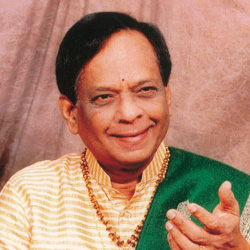
Listen to full collection of the recitals of Balamuralikrishna
Dr. Mangalampalli Balamuralikrishna was born on July 6, 1930 at Sankaraguptam, a small hamlet in Rajolu Taluk, East Godavari District in Andhra Pradesh, to Mangalampalli Pattabhiramayya and Suryakanthamma. His father, Pattabhiramayya was a famous flutist and a music teacher and Suryakanthama was a notable Veena artiste. His guru was the famous Parupalli Ramakrishnayya Pantulu. In the order of Guru Parampara, Balamurali Krishna is fifth in the line of direct disciples of the great Saint Tyagaraja.
In 1938, at the age of eight, he gave his first full-fledged performance. Not merely content with his name and fame as a concert vocalist, very soon he proved his immense versatility by playing the kanjira, mrdangam, viola and violin and the public flocked to hear his concerts. When he was barely 14 years old, he composed Raganga-Ravali, a detailed work on the 72-Melakarta (basic scales of music) scheme. By 16 he became a a Doctorate in music. He has served as music Producer at Vijayawada, Hyderabad and the Madras All India Radio Stations. In this capacity, he pioneered the early hour devotional renderings in India under the title ‘Bhakthi Ranjani’. He also acted as the first Principal of the Government Music College at Vijayawada.
He has created new raga-s like mahati, sumukham, trisakthi, sarvashri, omkari, janasamodini, manorama, rohini, vallabhi, lavangi, sushama, pratimadhyamavathi, etc. He has given more than 20,000 performances throughout the world and has created a world record by releasing over 250 audio cassettes brought out by the Sangeetha Recording Company.
He has bagged many titles and awards. The ‘Gana Sudhakara’, ‘Gayaka Sikhamani’, ‘Sur Singar’, ‘Geeta Kala Bharati’, Sangeet Natak Akademi Award, ‘Sangeetha Kalanidhi’, Padmashri and the coveted Padma Vibushan are some of them.
He was conferred the title of Sangeetha Kalanidhi in the year 1978. He was chosen as the ‘Wisdom Man of the Year in 1992’. He was also conferred the PhD, DSc and DLitt by the Andhra University, Jawaharlal Nehru Technological University, Sri Venkateswara University and the University of Hyderabad respectively. The Chief Minister of Andhra Pradesh honoured him with the ‘Atma Gauravam’ award in 1997. The Governor of Maharashtra honoured him for services rendered for the cause of National Integration. He is an Honarary First citizen of Vijayawada and has a road named after him in that city. He is a state musician of the states of Tamil Nadu and Andhra Pradesh and is the Asthana Vidwan of Tirumala Tirupati Devasthanam, Sringeri Peetam and Anjenaya Swami Temple, Nanganallur. He founded “Academy of Performing Arts and Research” in Switzerland and is also working on music therapy. He established the ‘MBK Trust’ with the objective of developing art and culture and for carrying out extensive research into Music Therapy. A dance and music school, ‘Vipanchee’ is a part of this Trust.
His greatest asset is his wonderfully vibrant, widely ranging, magnetic voice over which he has perfect control in all three octaves. He sings with a sense of infectious happiness with which he captivates his audience from the very first note. Balamurali Krishna mesmerises his audiences with his crystal clear enunciation of lyrics, the buoyant, cherubic and ever fresh quality of his music, his sparkling creativity and with the impressive ease with which he sings.
The great Swami Paramahamsa Chinmayananda said, “When music flows from Balamuralikrishna, you can realise what the crazy gopi’s felt in their ecstasy of Divine Love. To be born with music in his heart, to hold a recital at a tender age of only eight-deepavalis, to be at once a master in many instruments, apart from his unfailing purity of voice, tala and raga; these are indeed preciously rare in one single person unless he is a genius.”
Till the coming of Bamuralikrishna, the Carnatic music was dominated by the orthodox tradition bound Tamil musicians, who religiously stuck to what the old masters have composed. But this versatile genius not only grasped and churned the musical essence of the old masters but enriched it with his own superb variations. His rich voice swung from the highest octave to the lowest and aptly expressed the inner feelings and the deeper subtle meanings and emotions of the verses.
His smiling face radiated the sheer joy of singing and his emotion charged performances captivated the audience. This paved the way for other musicians to come out with and display their artistic talent, instead of mere repetition of the old masters. Some of his famous recitals like “Pibare Ramarasam”, “Sarigamapadani Paadeda”, “Sada Tava Pada sannidhim kuru”, “Eeteeruga nanu daya choochedavoo” are truly outstanding out of the world performances and leave an ever lasting impression on the listener.











